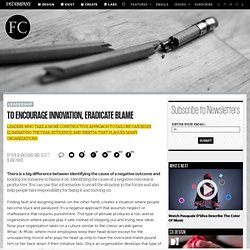

To Encourage Innovation, Eradicate Blame. There is a big difference between identifying the cause of a negative outcome and looking for someone to blame it on.

Identifying the cause of a negative outcome is productive. You can use that information to avoid the situation in the future and also help people take responsibility for fixing it and moving on. Finding fault and assigning blame, on the other hand, creates a situation where people become stuck and paralyzed. It’s a negative approach that assumes neglect or malfeasance that requires punishment.
This type of attitude produces a risk-averse organization where people play it safe instead of stepping out and trying new ideas. We know that the most innovative environments are those where people are allowed to learn from past mistakes, grow, develop, and improve. It’s also the approach used by WD-40 Company--manufacturers of the ubiquitous “water displacement” product of the same name--whose closely guarded formula was discovered on the 40th try back in 1953.
Innovation Doesn't Come On Demand, It Comes by Invitation Only. TED: Ideas worth spreading. Life Lessons From Benjamin Franklin. Benjamin Franklin was a man of action.

Over his lifetime, his curiosity and passion fueled a diverse range of interests. He was a writer (often using a pseudonym), publisher, diplomat, inventor and one of the Founding Fathers of the United States. His inventions included the lightning rod, bifocals and the Franklin stove. Franklin was responsible for establishing the first public library, organizing fire fighters in Philadelphia, was one of the early supporters of mutual insurance and crossed the Atlantic eight times.
Self-development was a constant endeavor throughout his incredible life. Benjamin Franklin was clearly a man who knew how to get things done. 14 Action Inducing LessonsLess Talk, More Action “Well done is better than well said.”Talk is cheap. “Never leave that till tomorrow which you can do today.” This is probably one of the first quotes I remember hearing as a teenager. Be Prepared “By failing to prepare, you are preparing to fail.”
You need a plan to accomplish your goals. What Doesn't Motivate Creativity Can Kill It - Teresa Amabile and Steve Kramer. By Teresa Amabile and Steve Kramer | 9:49 AM April 25, 2012 Management is widely viewed as a foe of innovation.

The thinking goes that too much management strangles innovation (just let a thousand flowers bloom!). But we have found a much more nuanced picture. You really can manage for innovation, but it starts by knowing what drives creativity in the people who generate and develop the new ideas that, when implemented, will become tomorrow’s innovations. Unfortunately, too many managers unintentionally kill innovation because they rely too heavily on carrots and sticks to motivate employees. More than three decades of research have shown that people are most likely to be creative when they’re intrinsically motivated by the interest, enjoyment, satisfaction, and challenge of the work itself. Savvy managers know how to balance four factors, to properly motivate creativity and, ultimately, innovation: Goals Evaluation Reward Some of the most positive rewards are not monetary. Pressure.
The Terrible Management Technique That Cost Microsoft Its Creativity. Apply the Right Kind of Pressure to Innovators - Management Tip of the Day - August 14, 2012.